YOU ARE VIEWING A DEMO REPORT
Beth Person

Career Advancement Report
Law School Transparency
Introduction 00
Back to Table of ContentsThe Career Advancement Report is designed to give you a detailed overview of of the specific traits and tendencies that make you who you are and provide the guidance that you need to make the most of those traits throughout your career. This guidance may also help you in school and to pass the bar exam.
Your personalized report contains the following chapters:
Cognitive Super Power: Your dominant Go-to Behavior is your Superpower, one that is fast, easy to use, and you may not even know that you have it or use it.
Distinctive Qualities: These are your most identifying characteristics, or how you're different from the norm as compared to our database of attorneys.
Visual Type & Go-To Behaviors: This is a visual model of Carl Jung’s Psychological Types showing that each person uses all eight behaviors.
Engagement Styles: Describes how you prefer to interact and engage with others you are working with in order to help you visualize how you can make the biggest and most significant contributions.
Four Styles of Working as a Lawyer: A look at your Thinking, Working, Motivational, and Business Development Styles -- all key things to know as a lawyer.
At Work Guidance: Tips to improve interactions with your colleagues, managers and subordinates at work.
Essential Motivator: Your core psychological needs, values, and talents
Essential Motivator Roles: Insight into the kinds of roles you will likely prefer based on what motivates you most.
Work Values: The values you likely seek in a workplace and job role.
Leader Style: Your leadership gifts and challenges.
Meeting Effectiveness: An activity to help you become more effective in meetings.
Building Relationships & Networking: An activity to become a more effective networker and build strong professional relationships.
Evaluating Career Options & Crafting a Career Plan: An activity to help your career search process.
Be sure to also check out your Law Fit report, which will help you discover what practice areas and work settings match your personality and strengths.
01 Cognitive Super Power - Expanded
Back to Table of ContentsThis section describes your Superpower; your dominant, "go to" behavior that is so natural, fast, and easy to access, you may not even know you have or are using it.
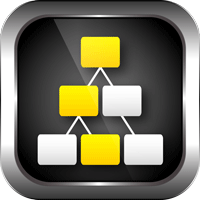
Super Analyzing
Beth’s Superpower
- Compelled to help by making certain everything is accurate and logically consistent
- Does everything in her power to ensure things are properly categorized, sorted, identified and labeled
- Beth may sometimes be overly critical in an earnest attempt to help and make things better
- She loves analyzing to uncover the one most perfect solution to a problem
- Beth typically thinks all problems can and should be solved by logic and reasoning
Good Day

System Thinker
Bad Day

Sarcastic Critic
Super Analyzing
Beth understands logic and analyzes or figures out the essential principles. That is what Super Analyzing is all about. Those with this superpower are constantly evaluating, defining, and identifying if something is correct or incorrect based on the sophisticated logical models and complex mental concepts they use.
For Beth it is very frustrating that most other people do not logically analyze or figure out their decisions. She often can't turn off the need to analyze things. Those with Super Analyzing are often dismayed because almost the entire world seems illogical or 'stupid' to them.
Her sophisticated analysis can sometimes result in a fairly biting wit. And when overused this can result in a perfectionist approach and evaluation of both herself and those around her.
It is also this constant mental sharpening that results in amazing progress on any problem that can be analyzed and solved by principles. Beth often thinks all problems can and should be solved by logic and reasoning.
Original work by: Sterling Bates Gene Bellotti © Step Research Corporation
02 Distinctive Qualities
Back to Table of ContentsBased on your results on the Sheffield Assessment, this chapter shows your most distinctive, "stand out" characteristics relative to the attorneys in our database.
We have ranked your scores on each of the 22 traits from the Sheffield Assessment in terms of how distinguishable they are from the scores of the attorneys, representing 24 different practice areas and 6 work settings, in our sample. Based on that ranking, this chapter highlights several traits where your scores could make you “stand out” from the crowd. If you want to see your scores on all 22 traits relative to satisfied attorneys in our world-wide database, you can find them in the chapter Legal Trait Analysis.
As much as we seek to measure everything perfectly, that's not actually possible. Indeed, no matter how good the Sheffield is, it is not able to predict whether you can or will be successful or satisfied in any particular work setting. Therefore, it's still incumbent upon you, as the expert on yourself, to look at the qualities and determine how important the opportunity to exercise them at work is to you.
For qualities you don’t place much weight on, knowing that they are less likely to be represented in a particular setting may not have much of an impact on how eager or interested you are to explore that work setting further. But for those you do care about, knowing how likely it is that these qualities will be well-represented can be useful information in helping you to prioritize which work settings to investigate first. Moreover, when there is a mismatch between the qualities that are important to you and what’s representative in an otherwise appealing setting, this information can help you anticipate the need to “sell” the value of these qualities, as well as to look for other avenues in which you can gain the satisfaction of using them.
Self-Starter
Beth frequently takes initiative to complete tasks without requiring instruction or supervision from others. People with strengths in this area will recognize a need, develop a plan for completing a task and work towards completion of the task all on their own. Individuals with above average levels of this trait also generally possess higher emotional intelligence, as they generally express their thoughts, feelings and beliefs in a direct, yet constructive way.
Development Opportunities:
Beth prefers to drive projects forward and does so comfortably without getting input from others. However, she may need to watch that she doesn't disregard important norms, rules, or procedures that others hold dear, even if Beth may fail to see their merit. Moderation and restraint can be important behaviors for Beth to cultivate. Beth can try stepping back and examining situations more closely and carefully before getting going.
Goal-Driven
Beth frequently sets goals for planning purposes or for measuring personal or organizational success. Her goal setting is a powerful process for thinking about her future, and for turning this vision of the future into reality. Multiple studies have shown that explicit goal-setting has been found to be a shared trait among highly successful people.
Development Opportunities:
Beth’s drive to manage her life and career, set goals, and work her plan usually promises that milestones get realized. Her resolve and determination are admirable but if not managed carefully, can keep Beth stuck; confining her to following the letter of her plan rather than operating out of the spirit of it. Without some attention to this inclination, Beth may find herself unable to take advantage of spontaneous opportunities to learn and grow because they aren’t on the schedule. Beth would do well to occasionally ask herself if her plans and goals are still as appropriate as they were in the beginning. If not, Beth would do well to reflect on what has changed, and what she might have missed by being so single-minded.
Predictability
Beth finds comfort in predictable, routine patterns. This is a positive characteristic for practice areas that are more stable and systematic in nature such as regulatory, tax, insurance, finance, and other related practices.
Development Opportunities:
Beth may need to balance the tendency to stick with the familiar by making an effort to seek fresh or unique perspectives. Starting a new tradition, in which Beth seeks to learn more about what makes a project or person especially interesting or noteworthy, can act as motivator to keep her going when things feel unpredictable. Being willing to entertain and explore trends or possibilities keeps the lines of communication open, allows a more comprehensive view, and may provide Beth with a heads-up about changes that lie ahead.
Original work by: Sterling Bates Mark Levin Karl Schmitt © Step Research Corporation
03 Visual Type™ and Go-To Behaviors
Back to Table of ContentsThis section is a visual model of Carl Jung’s Psychological Types showing how you use all eight behaviors and which two are dominant for you.
Visual Type™ provides a visual guide to the predictive use and accessibility of each behavior and an instantly recognizable way to see differences between people. This helps individuals with self-awareness. It also helps others understand what they can expect from the individual. The goal of this section is to make it immediately obvious to non experts how the functions relate to each other and the person based on their whole type.
Analyze
Decide based on logically correct or incorrect and evaluate the best approachBeth uses an internal, logic-based decision-making process that focuses on what is correct or incorrect. Beth looks inside before making decisions, using her mind to create order, to organize and categorize information, identify anomalies, deduce probabilities and understand how things work.
Invent
Look to the new and different ideas and explore many possibilitiesBeth uses brainstorming, a verbal questioning to identify patterns that provide insight. Beth looks to Invent as her go-to behavior for gathering information, she prefers seeking answers through brainstorming, identifying patterns and innovation. Beth looks outside the box for answers, seeking something new.
Understanding Beth's Visual Type™
- Beth's largest go-to box is Analyze, showing her strength of doing fact-based analysis of the problem based on data, not conjecture or opinion.
- What few people see below the line is how analytical she is when making decisions.
- Beth's supporting go-to box is Invent: brainstorming new ideas, starting new projects, thinking out of the box and finding creative solutions to problems.
- Beth's other three top boxes - Stabilize, Insight, and Value - are drafted to support her Analyze function, which she experiences as her Superpower of Super Analyzing.
You use all eight Go-To boxes but we expect that you find certain ones easy and fun and others slow and tough.
Think of the box size as telling you how natural you are likely to find activities related to that mental function. The smaller the box, the more energy it will likely take you to do any related activities. The bigger the box, the more likely you are to get energy from doing related activities.
The largest box is your largest function or Superpower.
The boxes above the line are what other people see - they are extraverted. The boxes below the line are introverted and are below the surface.
If your main go-to box is introverted, your most commonly used mental function is invisible to others. If your main go-to box is extraverted, others cannot see your supporting introverted box.
- Exciting
- Quick acting
- Risk taking
- Details
- Immediate need
- Exciting
- Quick acting
- Risk taking
- Details
- Immediate need
- Remembering
- Tells it from beginning to end
- Recalls in time sequence
- Details
- Nothing is too old
- Remembering
- Tells it from beginning to end
- Recalls in time sequence
- Details
- Nothing is too old
- Sharing ideas
- Takes a global perspective
- Brainstorming
- Identifies patterns
- Is not bothered by details
- Sharing ideas
- Takes a global perspective
- Brainstorming
- Identifies patterns
- Is not bothered by details
- Gaining insight from the unknown
- Having the “AHA”
- Connects the unconnected
- Difficult to explain
- Processes randomly
- Gaining insight from the unknown
- Having the “AHA”
- Connects the unconnected
- Difficult to explain
- Processes randomly
- akes a removed or objective perspective
- Sounds level headed
- Works from a defendable position
- Uses external tools
- Arranges data logically
- akes a removed or objective perspective
- Sounds level headed
- Works from a defendable position
- Uses external tools
- Arranges data logically
- Invisible to others
- Everything is connected
- Developed with precision
- Nothing exists unless it is complete
- Systematic process
- Invisible to others
- Everything is connected
- Developed with precision
- Nothing exists unless it is complete
- Systematic process
- Everyone is at peace
- Wants everyone to be happy
- Appreciates others’ involvement
- Harmony in the moment
- Connecting with others
- Everyone is at peace
- Wants everyone to be happy
- Appreciates others’ involvement
- Harmony in the moment
- Connecting with others
- Shielded from others
- Timeless
- Peace within
- Going it alone
- Often visible only when violated
- Shielded from others
- Timeless
- Peace within
- Going it alone
- Often visible only when violated
Now
: Look to the present and immediate needs and explore what is currently availableNow is very adept at identifying details about something that is happening right now and can be acquired through the five senses. People using NOW tend to be very aware and in the moment, seeking tactics that they can implement right now. Now looks to the present and the immediate moment for solutions.
Engaging to Experience
Alive in the moment and aware of what the senses are able to immediately experience
What's Happening Now
Alive in the moment and aware of what the senses are able to immediately experience
The Now function triggers an immediate reaction to or an engagement of what is perceived, so it may appear as if one is quickly changing from one activity to another or shifting interest quickly from one thing to another.
People who prefer to or naturally use Now to acquire information report liking to "live life to the fullest" or "live on the edge". Often the physical risks are exciting. They also report doing things or saying things that get a recognition or a reaction from others in the moment.
Stabilize
: Look to the past, traditions and what worked and focus on consistencyStabilize is abot keeping an internal database of details that have been learned in the past. Stabilize compares today's data with past data to make an informed decision. People using Stabilize tend to check their memory, make comparisons to the past, and in general look to the past to verify information.
Reliving to Verify
Recalling the details of past experiences and reliving the motions that accompany them
Resurrecting the Past
Recalling the details of past experiences and reliving the motions that accompany them
When active, Stabilize might appear to be slow in responding or unmoved by the present moment. This is because the focus is not on the present event. Instead it is on examining all past similar experiences.
When people who prefer, or naturally use, this mental function share the experience it is as if they were sharing the video tape that is playing in the brain. They also know that the devil is in the details, so expect them to be uncomfortable leaving out the details when they are talking and wanting you to include the details when you are talking.
Recognize that the experiences being recalled may have occurred eons ago, yet they are being talked about as if they only occurred yesterday.
Invent
: Look to the new and different ideas and explore many possibilitiesInvent is about brainstorming, a verbal questioning to identify patterns that provide insight. People using Invent tend to prefer seeking answers through brainstorming, identifying patterns and innovation. Invent looks outside the box for answers, seeking something new.
Recognizing Patterns and Possibilities
Creating possibilities for the future and spontaneously recognizing patterns and connections
Envisioning to Improve
Creating possibilities for the future and spontaneously recognizing patterns and connections
Invent when active in a positive way tends to view the opportunities and possibilities positively. Information shared through this function may seem to be superficial or broad brush as the details or what is beneath the surface can be filled in later. The expressions tend to be global in nature.
Insight
: Look to how things connect, the future and predict possible outcomesInsight is about the process of identifying seemingly disconnected patterns to result in instant insight into a problem or situation. When using Insight people tend to visualize their goal or end result, focus on strategy, synthesize data almost unconsciously and predict results with surprising accuracy. Insight looks to and visualizes the future for answers.
Discerning the Essence
Synthesizing information and identifying the central theme, vision, or significance
Insight of Holistic Meaning
Synthesizing information and identifying the central theme, vision, or significance
The insights that are received are like nuggets of gold; however, often the person receiving the nugget does not know how to immediately explain it to others so that they perceive it as a nugget of gold as well. This is often because the nugget appeared as a flash of light or insight without supporting information, so when one attempts to explain why the insight should be trusted the mind is blank. Reflection time is almost always needed to allow some bits of information to drift into consciousness to support the value of the insight. Memory is symbolic and images and ideas are ever-changing.
Execute
: Decide based on measurable goals and drive towards objectivesExecute is about plans, organizing, schedules, and measures. Execute structures the decision-making process by directing and interacting with other people. Execute focuses on measurable goals. When using it, people tend to think out loud, notice quickly when something is out of sequence or order, set objectives and criteria for success, and create step-by-step procedures. Execute looks to influence and organize the world, even when not solicited to do so.
Planning and Regulating
Establishing goals and applying objective analysis to arrive at a logical, defendable decision
“Operationalizing”
Establishing goals and applying objective analysis to arrive at a logical, defendable decision
With Execute everything is supported with logically analyzed data. Execute analyzes information within specific boundaries. Western states are different from northeastern states. We can think of Execute as establishing boundaries for the problem or boundaries regarding information that will be considered. Execute involves living by specific rules, regulations and laws and believing others should, as well.
Analyze
: Decide based on logically correct or incorrect and evaluate the best approachAnalzye is about using an internal, logic-based decision-making process that focuses on what is correct or incorrect. When using Analyze people tend to look inside before making decisions, using their mind to create order, to organize and categorize information, identify anomalies, deduce probabilities and understand how things work.
Understanding Systems
Repeatedly applying system analysis to data to fit them in one’s subjective mental framework
“That’s Better Defined This Way.”
Repeatedly applying system analysis to data to fit them in one’s subjective mental framework
These frameworks are built with precision and take a long time to be completed; therefore, they are not going to be quickly discarded in favor of a different framework. Because this is an introverted function the framework or system is not visible to others. Others often do not get a glimpse of the framework until they arrive at a decision that is not consistent with the framework, at which time they get to witness the volcanic explosion.
One can think of Analyze as an internal filing system. Each file contains sub-files, which contain sub-files, and so-on. Thus, when one is using Analyze, the time it takes to evaluate information may take a substantial amount of time, as the person must check to see if the information fits within one's complex filing system. If there is no place in the filing system for the piece of information to go, it will be rejected until more information is received.
Consideration
: Decide based on people's needs and empathize with othersConsideration is about giving the other person's personal needs high importance in making a decision. Consideration gives priority to the feelings of others. When using Consideration people tend to be friendly and considerate, try to create harmony between other people, act with kindness, and will disconnect with people who do not show that they care. Consideration looks to help others grow.
Affirming and Validating
Expressing appropriate concern and appreciation so group harmony is maintained
“You Really Did a Great Job”
Expressing appropriate concern and appreciation so group harmony is maintained
Consideration is genuinely 'other focused.' It is the mental function used to assess how others will react to certain decisions. It involves knowing the appropriate thing to do and is satisfied when others are content and working together.
This function evaluates based on the possible impact on others. It strives for peace externally or peace among others and is about making sure others are not disturbed, annoyed or in conflict. Consideration involves conversing and connecting with others, being with others, appreciating others and celebrating with others. It's all about 'others.'
Value
: Decide based on ethically right or wrong and sync with individual valuesValue is about aligning personal missions with being understanding. Value decides in a way that promotes win-win solutions with the priority on other people's feelings and their own personal ethics and morals. When using Value people tend to make decisions that focus on what is right or wrong according to their own internal values. They then expresses their internal values through external actions.
Liking or Disliking
Feeling internal tranquility when reality matches what is uniquely and deeply valued
“This is the Only Acceptable Way”
Feeling internal tranquility when reality matches what is uniquely and deeply valued
These values are shielded and protected from attack by others and thus may make us feel alone, vulnerable, or even on the defensive. There is a bit of mystery as to who this person is and there is a sense of tranquility and personal serenity. The values involved change very little, if at all, over time.
When these values are attacked, the reaction is often as shocking to those triggering the reaction as it is to the one who is reacting. It is as if a sudden, unexpected explosion has occurred that is the opposite of the serene inner harmony that is generally sought. Value strives for peace internally or an internal calmness and sense that everything is right.
Original work by: Sterling Bates Gene Bellotti Robert McAlpine © Step Research Corporation
04 Engagement Styles
Back to Table of ContentsThis section describes how you prefer to interact and engage when you are working with others in order to help you realize how you can make the biggest, most significant contributions.
Beth's Engagement Style:
- Your dominant engagement style describes how you prefer to interact and engage with others, especially when working on a project.
- Your engagement style can be helpful in identifying how you prefer to interact with teammates and how you make your best contributions.
- Each engagement style has several key opportunities for making a project successful.
- When an engagement style is overused, then that style can create threats to a project's success.
| Opportunities | Threats | Score | |
|---|---|---|---|
 Carefully Understand
Carefully Understand
|
Opportunities
|
Threats
|
30 |
 Refine for Perfection
Refine for Perfection
|
Opportunities
|
Threats
|
55 |
 Dynamically Explore
Dynamically Explore
|
Opportunities
|
Threats
|
10 |
 Organize and Direct
Organize and Direct
|
Opportunities
|
Threats
|
5 |
Original work by: Sterling Bates Gene Bellotti © Step Research Corporation
05 Four Styles of Working as a Lawyer
Back to Table of ContentsThis section takes a look at your Thinking, Working, Motivational, and Business Development Styles to highlight your natural abilities, core values, preferred work environments, and how these fit within the practice of law.
A list of the natural talents and abilities common to individuals with this person's personality type is listed below; any new job, career, or work setting that they are considering will hopefully leverage many of these natural talents and abilities.
Thinking Style
- Comfortable in the abstract and concrete: Beth is comfortable working through complex, multidimensional issues as well as simple, more concrete problems.
- Straight-forward: She prefers to work on projects that follow a straight-forward path or fall within a pre-defined, predictable scope.
- Habitual, routine: Beth exhibits comfort in following a predictable or routine pattern over seeking new experiences.
- Logical: Beth defaults to logic and critical thinking when analyzing an issue. She is adept at pattern recognition and reasoning.
- Optimistic: Beth tends to have a positive outlook towards life and events and she ffocuses in on the good in people or situations. This disposition is helpful for getting along with others and often leads to general happiness with one's career and life. Caution: Beth must remember to consider what might go wrong (play devil's advocate) when planning and making decisions relating to the future. Focusing on the positive outcome without consideration of the total picture or potential downsides can potentially have negative consequences.
- Risk averse: Beth tends to prefer conventional or well-established methods that will produce an expected outcome to a project or task as opposed to methods that may potentially lead to failure.
- Skeptical but not jaded: She tends to be somewhat skeptical, particularly when considering the motives of others. This is an important trait for making informed judgments in business situations.
Working Style
- Can perform with or without direction: Beth is able to get the job done with minimal input but will not resist direction or guidance.
- Respectful debater: Beth enjoys the challenge of convincing others but will allow them to maintain their point of view. She does not necessarily need to believe in the arguments she make/s, but it helps.
- More sympathetic than empathetic: Beth is capable of intellectually appreciating another person's experience, but is less adept at genuinely connecting with another's experience emotionally. She may not recognize more subtle aspects of communication.
- Can solve problems in group or alone: Beth is comfortable solving problems in either a group setting or alone, depending upon the situation and availability of others. Although we often think of autonomy and collaboration as two separate poles, the best business cultures often blend both and foster greater personal responsibility overall. In essence, everyone becomes more collaborative (building a stronger team or organization) as they become more autonomous (doing their individual parts).
- Collegial: Beth performs well as a teammate but can also step away from the group and continue to perform well on her own.
- Prefers closure on tasks before changing gears: Beth is capable of multitasking, but her preferred work style is to manage one or two important initiatives at a time. Beth can demonstrate urgency, but prefers to work at a steady pace.
Motivational Style
- Strong facade: Beth is capable of handling criticism or rejection but may question her convictions and experience some feelings of insecurity.
- Goal-setter: Beth frequently sets goals for planning purposes or for measuring personal or organizational success. For her, goal setting is a powerful process for thinking about the future and for motivating herself to turn this vision of the future into reality. Multiple studies have shown that goal-setting has been found to be common among highly successful people.
- Diligent: She tends to persevere through difficult circumstances in life and career. This is an important trait when working for a start-up or an entrepreneurial department in a larger organization.
- Confident: She is confident in her abilities but occasionally will seek validation from others.
- Proactive: Beth frequently takes initiative on tasks without requiring instruction or supervision of others. People with strengths in this area will frequently recognize the need to complete a task, develop a plan for completing the task and begin executing towards completion of the task all on one's own.
Business Development Style
- Client sympathetic when focused: Beth is capable of recognizing and understanding another's experience but does not always leave them with a genuine sense of having been understood. She can adjust her behavior based on the interpersonal situation, but this requires a conscious effort.
- Can listen well when focused: Although Beth listens to others and may pick up the facts in a conversation, she may miss the subtleties and may be inclined to fill in any gaps with her own assumptions.
- Poised, commanding: Beth exhibits a sense of ease, poise, and self-assurance. She can "turn it on" to command a room or conversation with a compelling energy and attitude. When used purposefully, this can be a highly effective tool for professional interactions.
- Sociable when needed: Beth is comfortable in social situations and she appreciates the benefit of networking, but both require effort.
Original work by: Sterling Bates Mark Levin Karl Schmitt © Step Research Corporation
06 At Work Guidance
Back to Table of ContentsThis section gives you tips about how to improve interactions with your colleagues, managers and subordinates at work.
Why it is important: Many people crave personalized guidance and mentoring at work - and this section provides just that in an automated fashion that is available on demand anytime a need arises. This guidance will help individuals, and their managers, be more effective at work.
Communication At Work Guidance
Talking to their Manager
Beth typically loves to be able to share in discussion of the theories and models she is using. It also works well for Beth to have her manager identify the theory or model being used as long as it is a logically accurate fit. Beth's pursuit of perfection, using the right models and holding herself to higher standards means that sometimes it is hard for her to provide deadlines for when tasks will be done.
Talking to Colleagues and Staff
Beth is typically great with helping colleagues develop their competence and understanding the theories of why they are doing it the way they are. Her focus on abstract theories sometimes misses the emotional support that certain coworkers need.
Difficult Conversations
For Beth, she will often find a creative logical solution to implement rather than have the argument directly. When the argument does come up, then Beth is likely to focus on logical methods to finding a solution. If she has not found a workaround solution and the issue is left to fester, then sometimes it can result in an explosive argument.
Doing Presentations
Beth is typically very good at taking complex theories and finding ways to display and share them very effectively in her presentations. She typically does her best work on her presentation while alone or with only one or two other experts. If there are too many people involved in building the presentation or lots of emotional issues than Beth is likely to find working on the presentation very taxing.
Managing At Work Guidance
Setting Goals
For Beth, it is typically very important that any goals being set fit into the logical situation at her work. Beth likely prefers focusing on goals that directly relate to her and her projects. If either setting the goals or achieving the goals requires a lot of interaction with others and is dependent on their success then Beth will likely be frustrated.
Team Building
Beth is typically very good at understanding the correct ideal theoretical arrangement for the team. She is very good at understanding the logical order for the team that allows each person to expand their skills and still get the job done effectively. While Beth is typically patient with people as they learn new skills if a team member continues to make the same mistake repeatedly than Beth can become very frustrated.
Leading
Beth is likely to prefer leading by doing her best to help make sure each person is doing their best. She will probably have a focus on leading through a logical and rational approach. Sometimes her preference for logical approaches can leave others feeling disconnected.
Delegating
Beth is likely to prefer delegating by gathering information and then determining what makes the most logical sense before delegating. Beth is probably most comfortable when everyone keeps things at a logical level. Her approach to gather information and confirm accuracy can sometimes not enough attention is paid to dates and deadlines.
Growing At Work Guidance
Time Management
Beth is likely to work well with a high degree of independent time to refine the her projects. All her work towards perfection is likely to mean that when suddenly presented with a deadline she can adapt and produce well.
Getting Feedback
Beth is likely to really appreciate being given feedback that is logical and relates to process at hand. Beth is probably very good and continually refining her thinking as she gets more data. Beth may sometimes fail to give an appropriate reaction to emotional feedback.
07 Essential Motivator - Expanded
Back to Table of ContentsEssential Motivators, your core psychological needs, values and talents as described by Linda Berens
Theorist
Beth’s Essential Motivator
Businesses are built on scientific discoveries and innovations.
Theory is the means to understanding the objective truth on which to build a path to achievement.
- Beth prefers using her gifts of strategic analysis to approach all situations
- She constantly examines the relationship of the means to the overall vision and goal
- No stranger to complexity, theories, and models, Beth likes to think of all possible contingencies and develop multiple plans for handling them
- She abstractly analyzes a situation and considers previously unthought-of possibilities
- Researching, analyzing, searching for patterns, and developing hypotheses are quite likely to be Beth's natural modus operandi.
Goals
Competence
Stressors
Powerlessness
Incompetence
Lack of knowledge
Theorist
Beth wants knowledge and to be competent, to achieve mastery. Beth seeks expertise to understand how the world and things in it work. She is theory oriented. Beth sees everything as conditional and relative. She is oriented to the infinite. She trusts logic and reason. She wants to have a rationale for everything. She is skeptical. Beth thinks in terms of differences, delineating categories, definitions, structures, and functions. She has a hunger for precision, especially in thought and language. Usually Beth is skilled at long-range planning, inventing, designing, and defining. Generally she is calm. Beth fosters individualism. She frequently gravitates toward technology and the sciences. She tends to be well suited for engineering and devising strategy, whether in the social sciences or physical sciences.
Needs & Values
Beth's core needs are for mastery of concepts, knowledge, and competence. She wants to understand the operating principles of the universe and to learn or even develop theories for everything. Beth values expertise, logical consistency, concepts, and ideas and seeks progress. She tends toward pragmatic, utilitarian actions with a technology focus. She trusts logic above all else. Beth tends to be skeptical and highly value precision in language. Beth's learning style is conceptual, and she wants to know the underlying principles that generate the details and facts rather than the details alone.
Skill Set
- Strategic Skill Set
- Think of and explain all the possible contingencies and influencing factors and then design processes for achieving the objectives
- Abstractly analyze a situation and consider previously unthought-of possibilities
- Look at the relationships between the goals and the means for unintended consequences
- Identify ways to improve and make progress relative to long-term goals
- Integrate ideas into cohesive theories and design processes that strategically meet the wants and needs of others
- Implement a vision of the future—conceiving of a way to be in the future as well as the action steps needed to get there
- Generate and share a multitude of ideas and possibilities for action
- Mobilize and coordinate the actions of others to implement a strategy
08 Essential Motivator Roles
Back to Table of ContentsYour preferred roles based on your essential motivator
Preferred Roles With Opportunities
More Beth
Less Beth
Theorist
Beth Prefers A Role With Opportunity For:
- Being competent and curious
- Having intellectual independence
- Finding a better way
Less Beth
Catalyst
- Feeling unique or special
- Having a purpose or meaning
- Making a difference
Improviser
- Fun, freedom and variety
- Doing it with style
- Making an impact
Stabilizer
- Achieving concrete results
- Taking responsibility
- Belonging and contributing
09 Work Values
Back to Table of ContentsThis section uses your personality type to help illustrate what sort of values you likely support for work.
Beth's core values likely include:
Her professional environment should align with her core values in order to achieve maximum job satisfaction and career success. The common core values for her personality type include:
- Demonstrated competence
- Achievement
- Creativity
- Ingenuity
- Knowledge
- Constant learning
- Excellence
- Perfection
- Independence
- New challenges
- Being calm, emotion free
- Logic
- Minimal repetitive work
- Rewards and recognition are for problem solving in creative and innovative ways
- The ability to work without much direction is appreciated
010 Leader Style
Back to Table of ContentsThis chapter helps you understand your leader style gifts and challenges
Expansive Analyzer
What People See
Beth's Gift as a Leader
What Beth Might Miss
Beth's Leadership Self-Development Activity
Beth does best when she takes plenty of alone time to recharge, especially before meeting with her teams. Beth would benefit by telling team members that's what she is doing, to avoid misunderstandings.011 Meeting Effectiveness
Back to Table of ContentsThese describe various ways to become more effective in meetings
Practice new skills: Homework/In-Session Activity
- Look through the 4 preference sections below, scanning the ways to be more effective.
- Choose one of the 4 preferences to work from.
- Choose 3 of the "Ways to be more effective" in that preference to practice.
- Create an action plan for applying these suggestions:
- When can I practice this suggestion...
- What specific actions will I do differently in a meeting...
- Continue to try out these specific action plan for a month and then repeat again with a different preference or suggestions.
Preference for Introversion
The opposite is called ExtraversionWays to be more effective in meetings:
- Prepare
Ask for an agenda and the meeting material before the meeting so that you can prepare how you will contribute to the conversation. - Talk more
Speak up. Share your point of view. Do not wait too long. Interrupt when it is necessary, even if it feels uncomfortable. Show your enthusiasm – do not keep it to yourself. - Resist pressure
Be patient if others try to finish your sentences or insist that you say something. Point out that you need a moment to think. - Be patient with thinking out loud
Do not assume that those who talk a lot during meetings are not interested in your input. They are probably working through an idea by talking about it, or they expect you to contribute when you have something to say. - Use your body language
Maintain eye contact with the person speaking and show with your body language that you are interested in what he or she is saying. Nod, smile, lean forward. - Engage
Accept that sometimes the best way to understand a new situation is to engage in it and learn from the experience. - Accept the need for a meeting
Remember that people who prefer E are energised by social interaction, and that they think best when talking or sharing with other people. They may also want to meet face to face to ensure that everyone is on the same side. Accept it, even if you do not yourself consider it necessary to meet.
Preference for Intuition
The opposite is called SensingWays to be more effective in meetings:
- Stick to the point
Restrain your urge to look for associations, related topics and “what-if”s during discussions. Stay focused on the specific issue under consideration. - Stay attentive
Focus on the discussion and the meeting also while discussing specific, concrete issues and facts. Do not let your thoughts wander off. - Be realistic
Even though you believe that something is not working as well as it could, be open to a discussion of whether the benefits of the change outweigh the costs. Remember also that small changes are easier to implement than big ones. - Draw on experience
Include past experience and expertise in discussions when something needs to be changed. Ask about others’ experience. - Listen to objections
If others are hesitant about changes, assume that they have a good reason, and encourage them to express their concerns. Take objections about feasibility seriously. - Explain more
Put more words on your insights than you find necessary. People who prefer S tend to think that the contributions of those who prefer N are too jumpy and incoherent. Help them understand how your ideas will work in practice. - Leave time for concrete information
Be sure to provide enough details to the people who prefer S at the meeting to ensure they have an adequate basis for discussion. Be patient with their need to talk about the details, and then gently bring the discussion back to the task at hand.
Preference for Thinking
The opposite is called FeelingWays to be more effective in meetings:
- Create a good setting
Start the meeting by making an effort to create the right atmosphere. Do not jump right in. Allow the participants to find their legs. - Soften your language
Avoid blunt communication unless the situation requires it. Tone down your language so that others do not switch off because you said it “that way”. Be friendly. - Establish ”common ground”
In a discussion firstly talk about areas of agreement that way establishing ”common ground” maintaining a good atmosphere. Focus on expressing the positives before the negatives – otherwise people who prefer F may believe you are opposed to an idea, which can demotivate them. - Allow room for values and subjective data
Remember that those who prefer F tend to make better decisions when they include personal values. Accommodate this at the meeting. - Pay attention to feelings
Focus on others’ feelings and needs, both at the meeting and in regard to the decisions being made. Make an effort to understand and incorporate others’ points of view when making a decision, even if you disagree with what they have said. - Combine logic with values
Use your own personal values to complement your logical arguments and analyses, especially when discussing decisions that affect people. People who prefer F are more likely to be persuaded by arguments which incorporate values and not just pure logic.
Preference for Perceiving
The opposite is called JudgingWays to be more effective in meetings:
- Be on time or before
Have a list of small tasks on your mobile you can work on to avoid the feeling of ”wasting your time” before the meeting starts. - Decide
Do not let your desire to gather more information and keep your options open keep you from making a timely decision. - Leave time to organise
Understand that your need to try several different approaches can overwhelm people who prefer J. Allow time for a discussion on how to organise, so they do not switch off. - Control the improviser
Try not to rely so much on your ability to improvise that you reach the point where you avoid planning. Remember that people who prefer J take plans seriously. - Volunteer to initiate the process
Offer to take on tasks in the initial phase of a project when your energy level and your enthusiasm are at their peak. - Control your inner time optimist
Be realistic about the time it will take for you to complete a task, so you can keep your promises. - Keep an eye on the agenda and the time
Be careful not to stray too much from the agenda, and do not reopen decisions unless it is crucial. Be realistic about what you can achieve at the meeting. Sometimes there is no time to consider a subject from all angles. - Be aware of deadlines
Listen for agreements on deadlines at the meeting and write them down. Ask when others expect your input.
Original work by: Mette Babitzkow Boje Tina Brøndum Kristjánsson © Step Research Corporation
012 Building Relationships & Networking
Back to Table of ContentsHelping a student maximize their strengths in building relationships and networking
Troubleshooting Common Problem Behaviors and Shifting Perspectives
Beth can address her limiting belief by taking a proactive approach. When taking part in a discussion, she can say:
- "What brought you here today and what makes being at this event worth your time?"
- "What’s most challenging about this subject, what do people struggle to master when looking into this topic?"
- "What is the most surprising thing you have seen or heard so far today and what makes you curious to learn more?"
Beth can show interest this way even if she feels out of place making casual conversation. She can also use other peoples’ responses as a basis for her next comments or to spur conversation.
- Explain to Beth that people often feel that they need to act out of character to succeed in networking situations. Although it’s important to put one’s best foot forward, this can be achieved without trying to act like someone else. To help Beth resist the temptation to put up a false front when meeting new people, encourage Beth to develop an alternative mindset.
- Tell Beth “Networking is a low stakes but high potential opportunity to form and/or strengthen helpful connections. You will be most successful when you practice being professional by:
- Being yourself, realizing that this is the best way to find and match yourself to those who can use and appreciate your special characteristics.
- Valuing others’ input while recognizing that no matter the result or ultimate benefit to you of any interaction, it’s always best to approach the process with courtesy and respect.
- Politely excusing yourself if a conversation doesn’t seem fruitful by thanking others for their time before moving on to find another person to speak to – knowing that this is perfectly acceptable and that your courtesy is not only the right thing to do, but can result in your being remembered favorably, helping you in the future.
- Along with practicing professionalism, support Beth’s efforts to adopt this new mindset by suggesting she adds her “special sauce” to the networking experience by:
- Listening, keeping the conversation going by asking questions which call for more information and showing interest by giving others time to speak.
- Making the most of the conversation by asking questions about general themes and sharing ideas and inspirations.
- Analyzing the logic behind any data presented and striving for, as well as seeking, precision and clarity when sharing ideas or considering the ideas of others.
- Helping others through sharing expertise.
Bonus Tip:
A simple strategy that can help Beth be more confident in networking is for her to be ready to share some of her best qualities. Having prepared a quick, simple statement about what makes her special is a great help to both Beth and the person with whom she is trying to network. It adds clarity to the interaction and helps put people at greater ease.
Three adjectives likely to describe Beth well are:
Analytical, truth seeking and rational
Tell Beth that being able to identify and talk about her unique strengths is more meaningful and powerful than merely reciting from her resume or simply listing her skills. Encourage Beth to use these three words when asked to share something about herself, preparing examples from her own life to illustrate these characteristics.
Practice new skills: Homework/In-Session Activity
Because networking is so often misunderstood, it’s important to demystify it. These activities will help Beth become more skillful at, and less intimidated by networking – challenging her assumptions and showing her how to apply what she has learned. Networking, by its very nature, is about doing. The two activities provide a starting place for Beth to develop, and hopefully enjoy, this highly useful practice – giving her a means to tap into resources she might not have realized she has.
- Tell Beth that networking isn’t just about going to large gatherings and talking to strangers. Networking is happening anytime and anywhere people are connecting and learning more about each other. Brainstorm a list of her connections with Beth to help her see that she already has a network, one made up of people such as in the list below.
- Ask Beth to select three or four items from the list of questions below and then tell Beth to try them out the next time she meets with someone from the list of people just generated. Tell Beth to use this as a way to learn more about the people she knows and deepen her connections with them.
- Use the results of this exercise to show Beth that she has many more resources than she might have thought and that there are always new things to learn from the people she already knows. Taking the opportunity to begin networking with people who already care about her can help Beth to feel more poised and positive about her relationship-building and networking skills.
Beth Person
Networking Really Is About Who You Know

Instructions For Using This
- Networking isn’t just about going to large gatherings and talking to strangers. Networking is happening anytime and anywhere people are connecting and learning more about each other.
- Brainstorm a list of your connections:
- Write them out on the bottom half of the page or use Polish
- Start with any people who fit into the categories below:
- Relatives
- Friends and acquaintances, including neighbors past and present
- Teachers past and present
- Coaches past and present
- Fellow members of her/his faith community, club, sports team, hobby group, community organization, social media platforms, etc.
- Who else might be part of your network, people that you already know?
- Ask people in your network questions from the list below:
- Select three or four items from the list of questions below
- Try them out the next time you meet anyone from the list of people just generated.
- Use this as a way to learn more about the people you know and deepen your connections with them.
- Use the results of this exercise to show yourself that you have many more resources than you might have thought and that there are always new things to learn from the people you already know.
- Take the opportunity to begin networking with people who already care about you and that can help you to feel more poised and positive about your relationship-building and networking skills.
I can enhance my connection with others using the following questions:
- What helped them to stick with classes where they didn’t respect the teacher?
- What helped them to stick with classes with a boring teacher?
- What helped them to stick with classes with a disorganized teacher?
- What helped them to stick with classes where they didn’t like the teacher?
- How did they figure out how to convince people that they had a good idea?
- How did they figure out how to convince others to take action?
- How did they figure out how to stand up for what they believe in when others disagreed?
- How did they figure out how to convince others that it is important to pay attention to how people feel about a plan?
- What helped them to be more disciplined about...?
- What helped them to be more relaxed about...?
- Tell Beth that a great way to increase her networking skills is to look at what is already going well for her and then make an effort to do more of those things that make her feel good and have led to successful results. This sort of appreciative, glass-half-full approach, with its focus on the positive, typically energizes people much more than looking at what’s wrong or not working.
- Ask Beth to complete the two stems below by selecting two or three items from the list of verbs, and two or three from the list of adjectives that describe her behavior when she felt really engaged in and excited about building relationships and/or networking.
- Have Beth choose one item from her list of verbs and one item from her list of adjectives and describe two ways she can practice these two approaches to building relationships and networking more often. Having a plan of action to develop the networking skills that Beth sees as vital should increase her confidence and make her networking more authentic and effective. This can be homework or you can work on it together in the session.
- Use the results of this exercise to show Beth that she has reasons to feel more poised and positive about her relationship building and networking skills.
- As a follow-up you may want to ask Beth about those areas that she finds difficult or less natural when networking. One way to facilitate this is to ask Beth about some of the verbs and adjectives that she did NOT choose in step 2. Often the things that are off-putting to us can help us learn about both our blind spots and our fears and serve as a means to figuring out how to manage them, as well as open us up to considering areas that seem like a stretch, but if given the opportunity, might be interesting and fun to try out.
Beth Person
An Appreciative Approach to Networking

Instructions For Using This
- A great way to increase your networking skills is to look at what is already going well for yourself and then make an effort to do more of those things that make you feel good and have led to successful results. This sort of appreciative, glass-half-full approach, with its focus on the positive, typically energizes people much more than looking at what’s wrong or not working.
- Complete the two stems below by selecting two or three items from the list of verbs, and two or three from the list of adjectives that describe your behavior when you felt really engaged in and excited about building relationships and/or networking.
- Choose one item from her list of verbs and one item from her list of adjectives:
- Describe two ways you can practice these two approaches to building relationships and networking more often.
- Having a plan of action to develop the networking skills that you see as vital should increase your confidence and make your networking more authentic and effective.
- What reasons do you have to feel more poised and positive about your relationship building and networking skills?
- Follow up:
- Which of the verbs or adjectives do you find more difficult or less natural when networking?
- It might be easier to start this by thinking about the verbs and adjectives that you did NOT choose in step 2
- Often the things that are off-putting to us can help us learn about both our blind spots and our fears and serve as a means to figuring out how to manage them, as well as open us up to considering areas that seem like a stretch, but if given the opportunity, might be interesting and fun to try out.
I can enhance my networking by appreciating my strengths:
When I feel best about networking, I am...
VERBS:
talking
sharing general impressions
sharing details and specifics
searching for inconsistencies
searching for points of agreement
During networking it is very important for me to be…
ADJECTIVES:
expressive
task-focused
people-oriented
flexible
structured
Original work by: Elizabeth Hirsh Katherine Hirsh © Step Research Corporation
013 Evaluating Career Options & Crafting a Career Plan
Back to Table of ContentsThe career search process is not a one-size-fits-all proposition and therefore an important initial step for a person is finding an approach that works for them.
Evaluating Career Options & Crafting a Career Plan
- Reflect on her own and choose just a few career options to research in depth.
- Look at her dreams, hunches, and off-the-wall ideas for clues about which career options to consider more deeply.
- Ask herself whether the possible career choices she has identified have more positives than negatives.
- Respond to new information, chance meetings, or spontaneous opportunities that keep her career search fresh.
- Do people in this field value autonomy, independent work, and in-depth consideration of issues?
- Do people in this field value imagination, insight, and reaching toward an ideal future?
- Do people in this field value objectivity, critical analysis, and data?
- Do people in this field value freedom, adaptability, and openness?
Practice new skills: Homework/In-Session Activity
- Show Beth the Z-Model Handout below, and call out that the processes she likely uses effectively (these are highlighted in blue).
- Ask Beth to pick out at least two items that most surprised her from the processes she is less likely to utilize.
- Have Beth create an action plan for applying these questions:
- When I am selecting which careers to explore, I need to ask myself...
- When I am evaluating of the appeal of different careers, I need to ask myself...
- Encourage Beth to continue testing her assumptions about what makes for a good career by asking new questions about her career options.
Z-Model Handout
Beth Person
Career Decision-Making

- How does this career option take advantage of skills I already have?
- What direct experience do I need?
- What existing knowledge will I be able to apply?
- What is the customary entry point for this career?
- How does this career option stretch abilities I already have?
- What experiences of mine might be transferable?
- What new knowledge will I be able to obtain?
- What alternative entry points exist for this career?
- What are the advantages and disadvantages of this career option?
- What reasons support choosing this career?
- What parts of this career would I find most challenging?
- How does this career promote competence?
- What are the most rewarding and most stressful aspects of this career option?
- Would choosing this career fit my values?
- What parts of this career would I find most meaningful?
- How does this career promote personal satisfaction?
Original work by: Elizabeth Hirsh Katherine Hirsh © Step Research Corporation
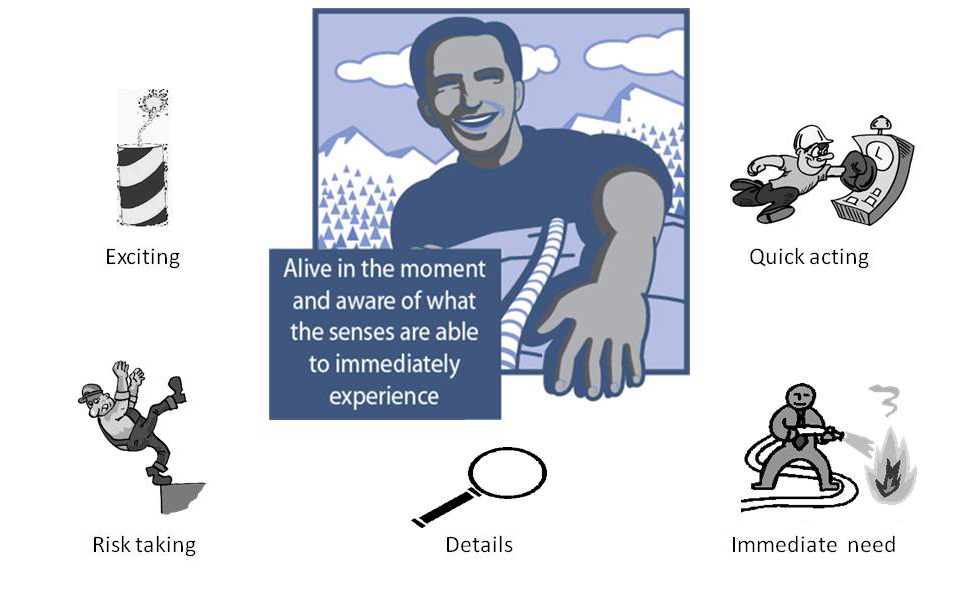
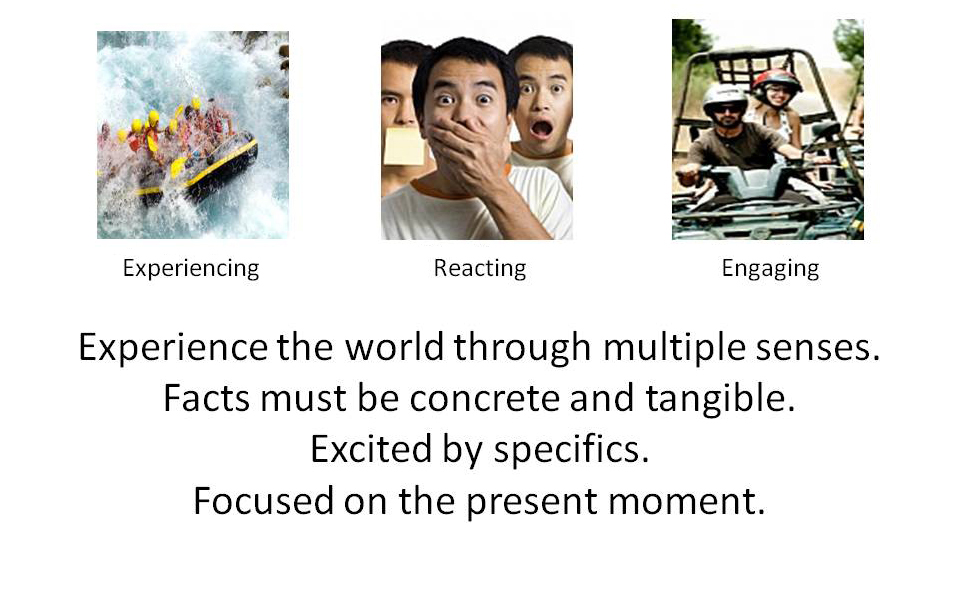 Now is about immediately engaging the world around us. We do this by perceiving information through any of our five senses. We might even be using multiple senses simultaneously. Remember we are talking about concrete information; otherwise, it would not be information we perceived through one of the senses.
Now is about immediately engaging the world around us. We do this by perceiving information through any of our five senses. We might even be using multiple senses simultaneously. Remember we are talking about concrete information; otherwise, it would not be information we perceived through one of the senses.
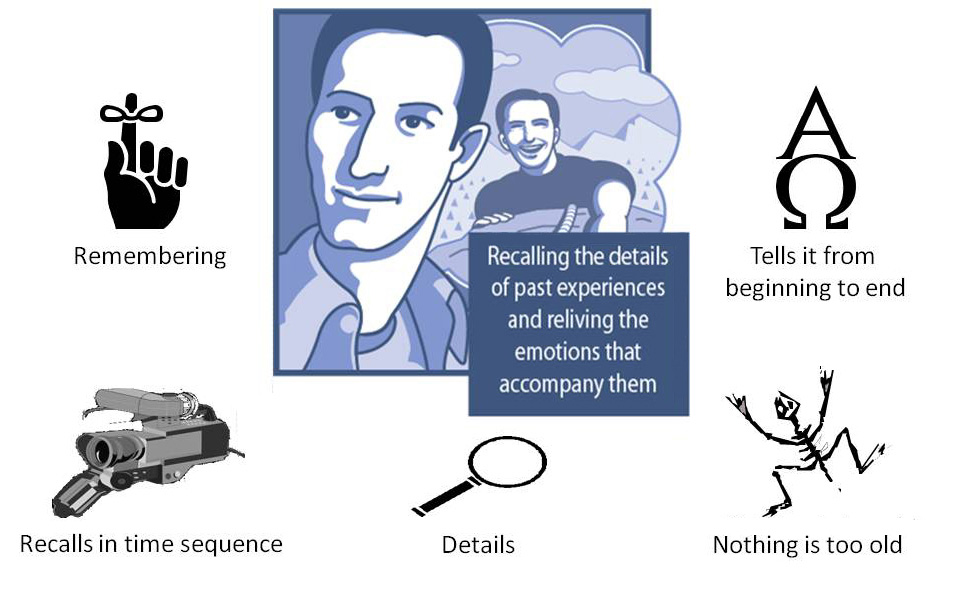
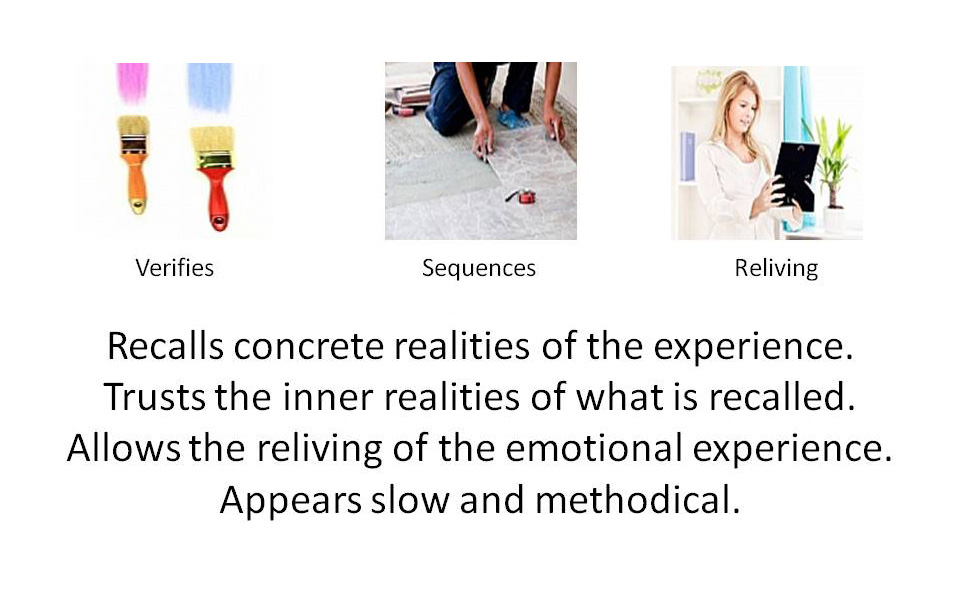 Stabilize is about checking out the present information by comparing it to previous experiences with similar information. We do this by recalling and reliving the past experiences in our lives. These are concrete experiences that include the emotional experiences or reactions we had to the experience being recalled. The recalled experiences are recalled from start to finish and if they are shared everything from start to finish must be shared.
Stabilize is about checking out the present information by comparing it to previous experiences with similar information. We do this by recalling and reliving the past experiences in our lives. These are concrete experiences that include the emotional experiences or reactions we had to the experience being recalled. The recalled experiences are recalled from start to finish and if they are shared everything from start to finish must be shared.
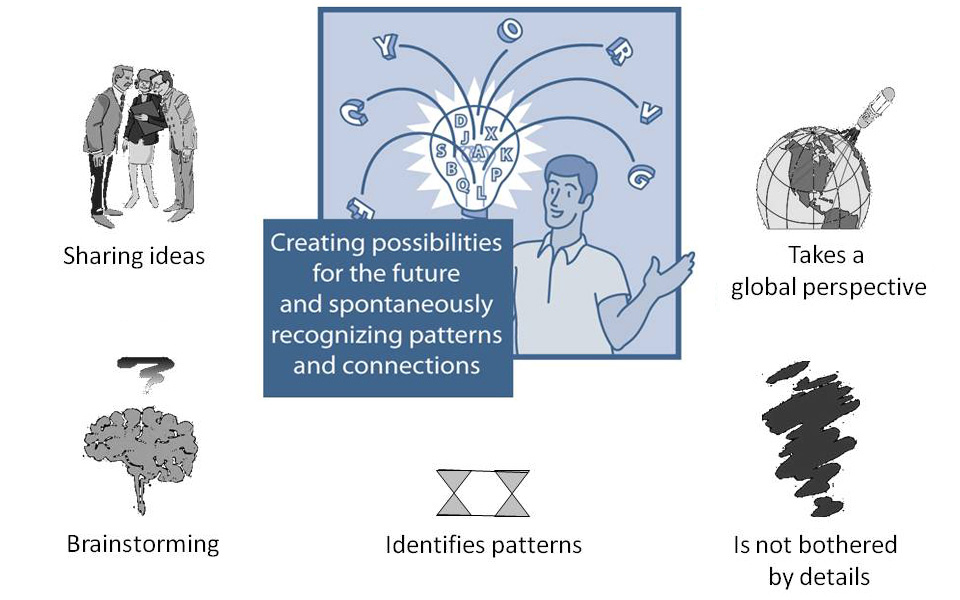
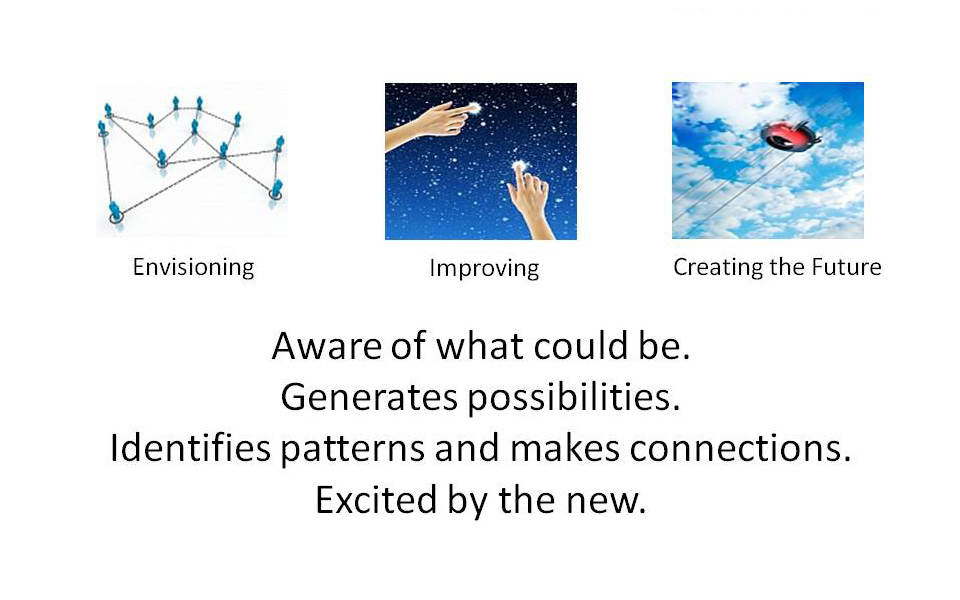 Invent is about identifying possibilities and opportunities related to what is happening in the real world. It is generating new ideas based on old ones. It is creating new ideas based on what someone else has shared. It expands one idea into many possibilities without the need for precision or detail.
Invent is about identifying possibilities and opportunities related to what is happening in the real world. It is generating new ideas based on old ones. It is creating new ideas based on what someone else has shared. It expands one idea into many possibilities without the need for precision or detail.
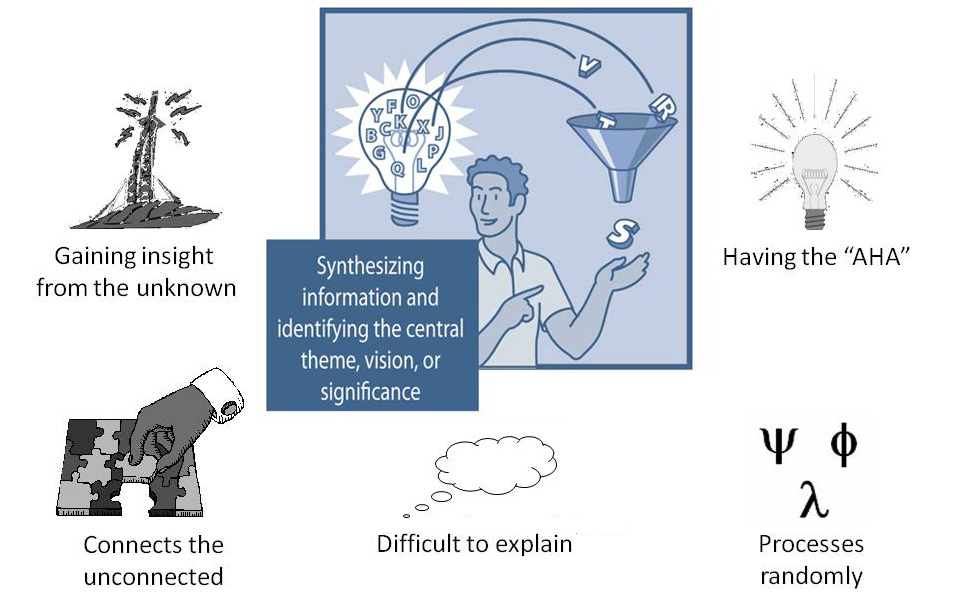
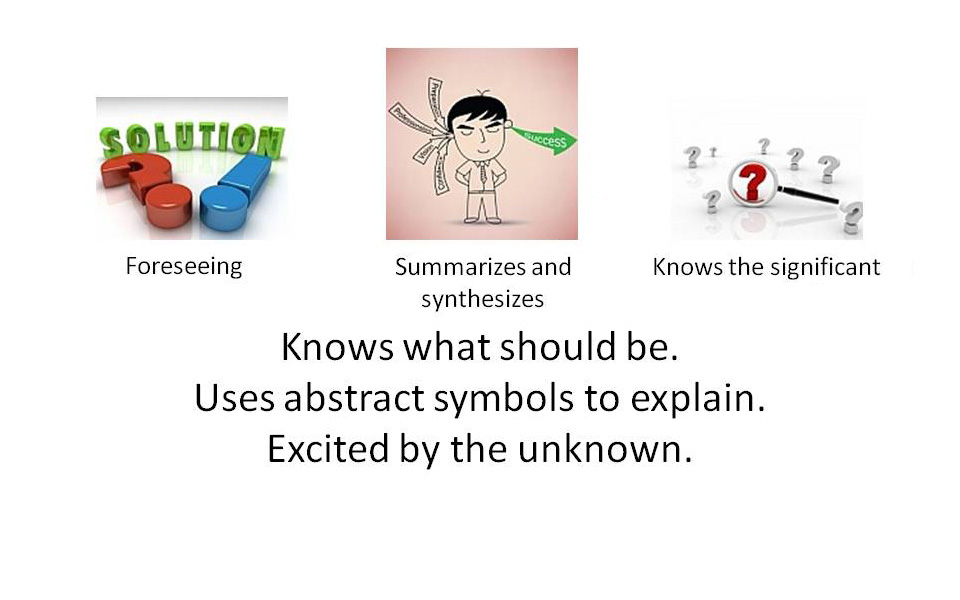 Insight identifies the opportunity or possibility that is the "best" without really knowing how it was identified. It is like a receiver getting signals from an unknown TRUSTED source. It tends not to focus on intermediate steps instead focusing on the end goal. One might connect with Covey's "Start with the end in mind" as an introverted intuiting approach.
Insight identifies the opportunity or possibility that is the "best" without really knowing how it was identified. It is like a receiver getting signals from an unknown TRUSTED source. It tends not to focus on intermediate steps instead focusing on the end goal. One might connect with Covey's "Start with the end in mind" as an introverted intuiting approach.
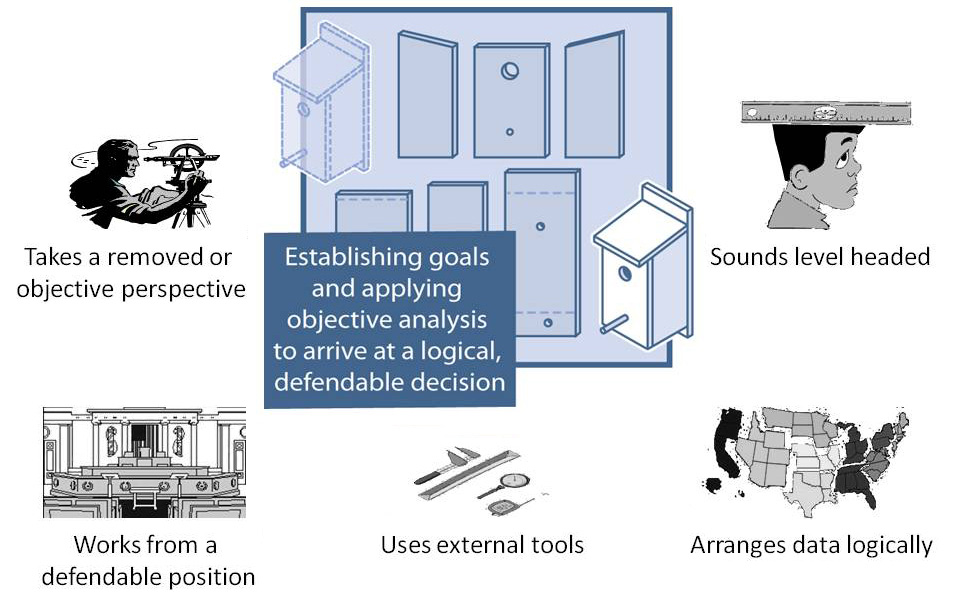
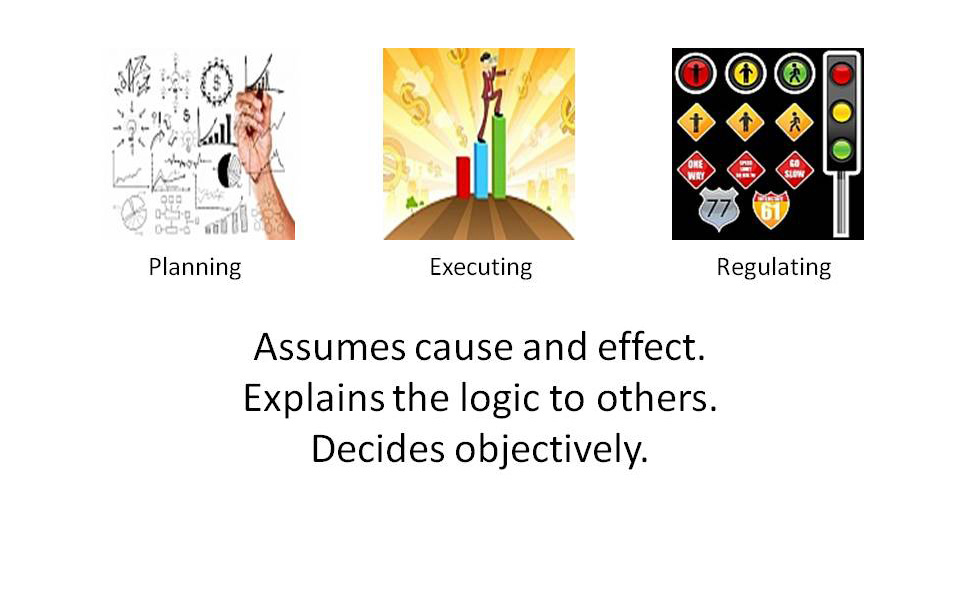 Execute uses accepted tools and techniques to evaluate the information much like surveying instruments are used to determine a specific location. This process organizes information in an orderly manner so the information can be analyzed objectively or impersonally.
Execute uses accepted tools and techniques to evaluate the information much like surveying instruments are used to determine a specific location. This process organizes information in an orderly manner so the information can be analyzed objectively or impersonally.
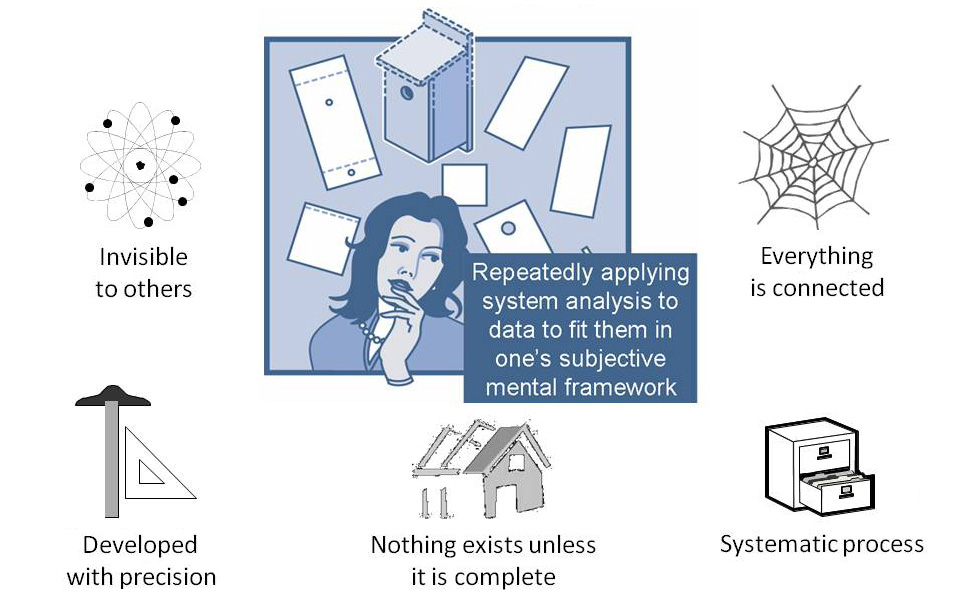
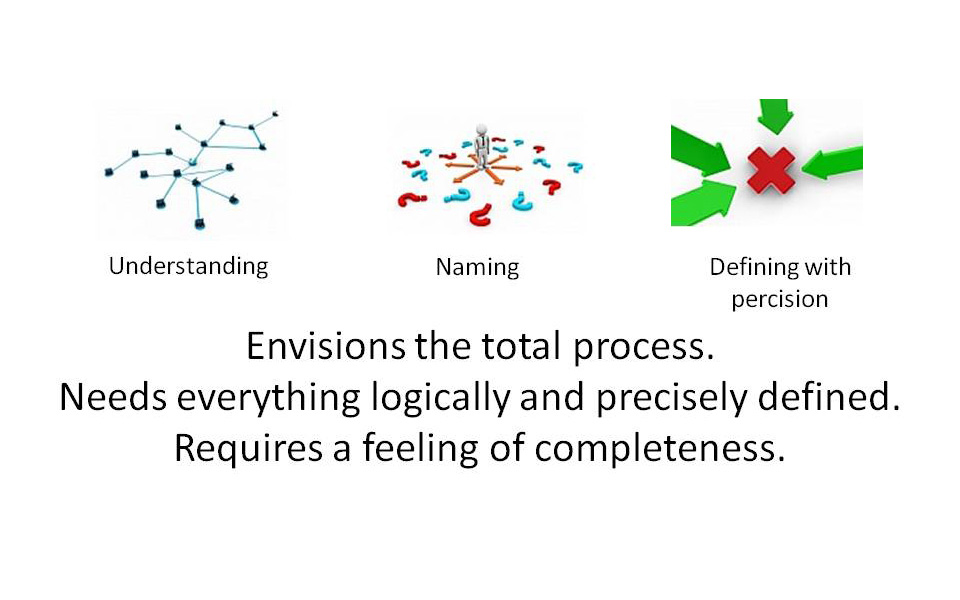 Analyze evaluates information based on how consistently and precisely the information fits within established internal systems or frameworks.
Analyze evaluates information based on how consistently and precisely the information fits within established internal systems or frameworks.
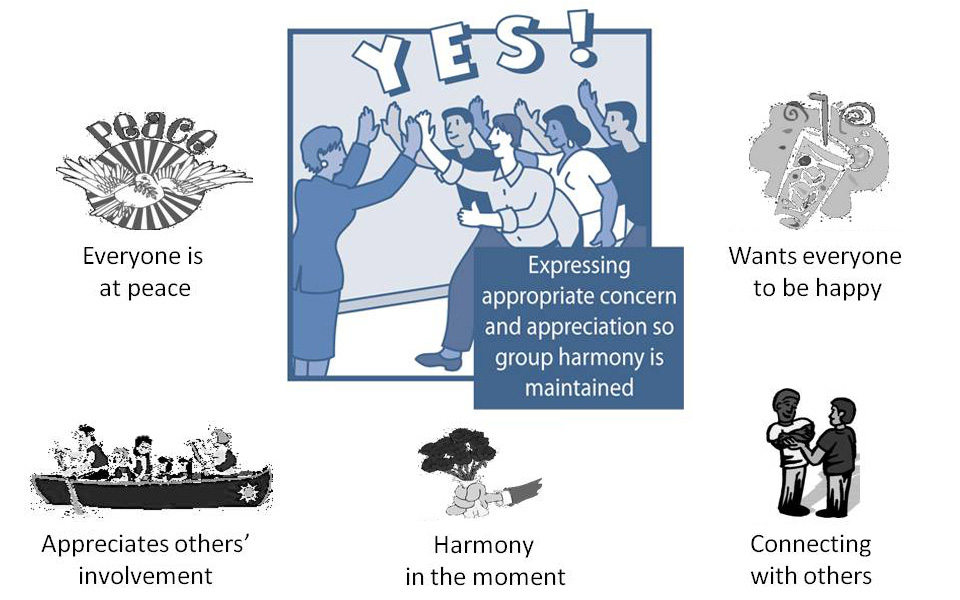
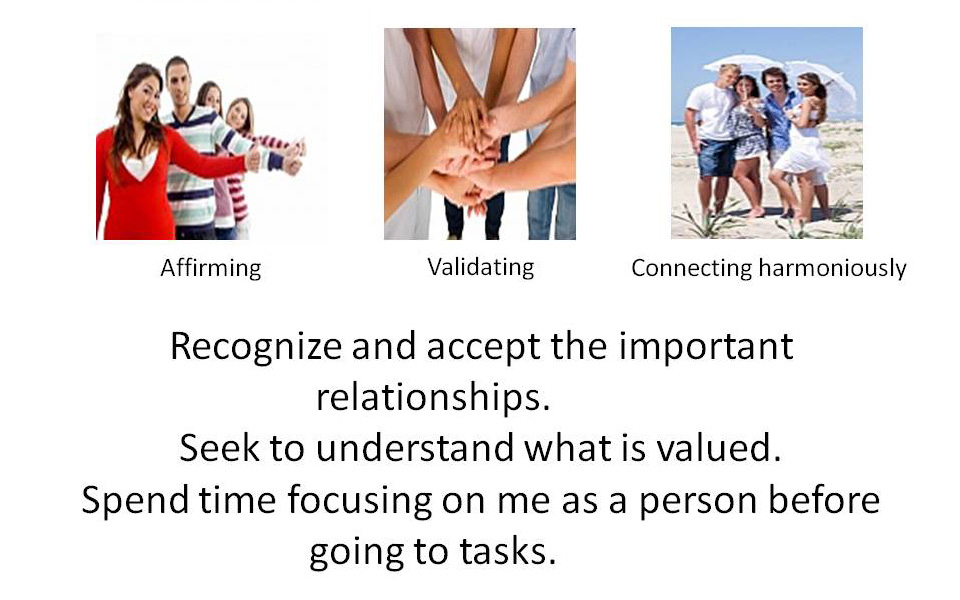 Consideration is about tuning in/noticing/reading the mood or the practical needs of others and then addressing or satisfying those needs.
Consideration is about tuning in/noticing/reading the mood or the practical needs of others and then addressing or satisfying those needs.
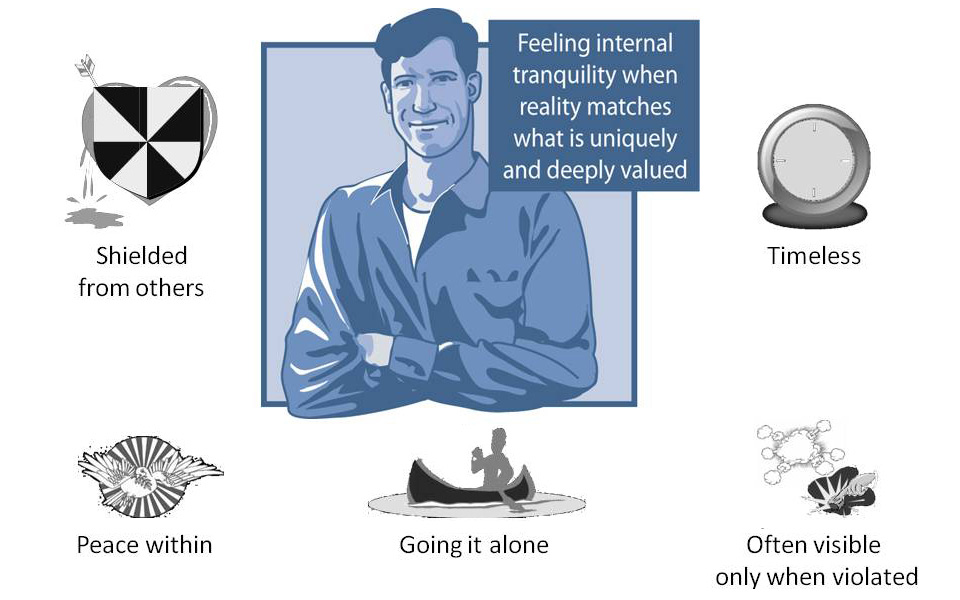
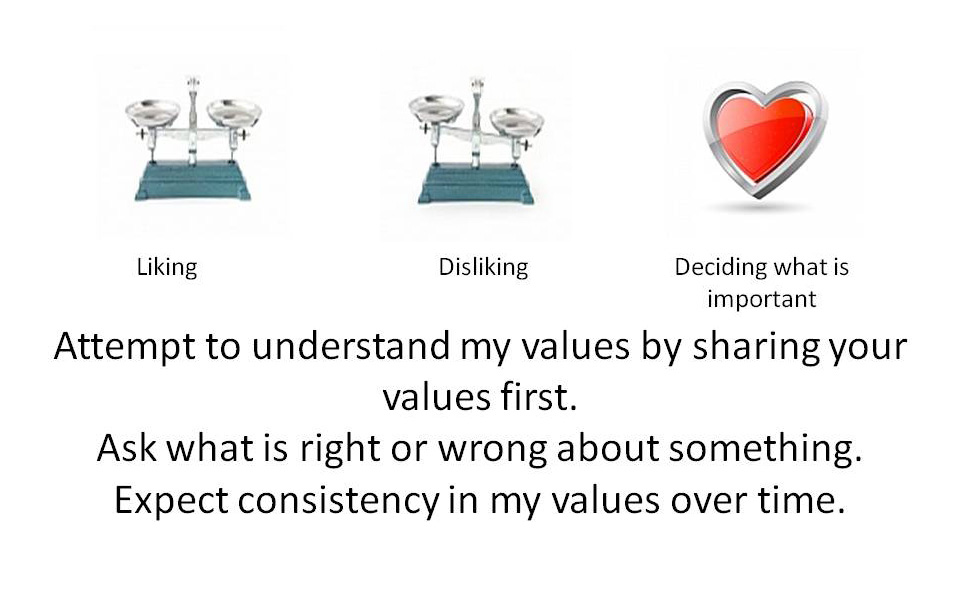 Value evaluates information based on one's unique values. It is easy for one to apply these values to identify what is right, but it is difficult for one to explain to others what one is using to determine what is right.
Value evaluates information based on one's unique values. It is easy for one to apply these values to identify what is right, but it is difficult for one to explain to others what one is using to determine what is right.